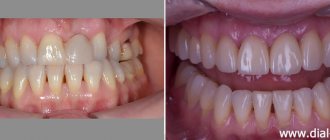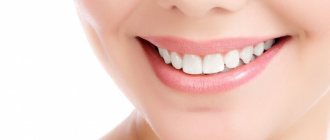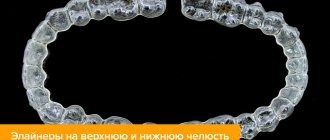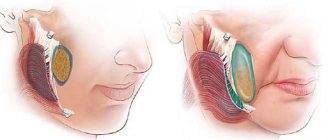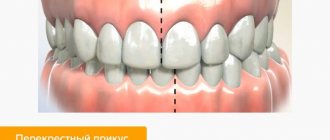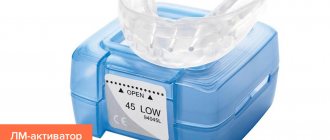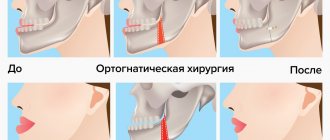Patients who call an orthodontic center to make an appointment are first of all interested in the cost of teeth straightening. The answer to this question can serve as an indicator of the quality of treatment in the center, since a specific amount can only be named after examining the patient, diagnosing the condition of his teeth and drawing up a treatment plan.
Installing braces is usually only part of a voluminous and lengthy job, and the final amount may include not only the cost of braces , but also the cost of caries treatment, tartar cleaning, and sometimes even tooth extraction.
Of course, the treatment plan proposed by the orthodontist must be explained to the patient and agreed with him. And at this stage, problems most often arise due to the need to remove several teeth, voiced by the doctor.
Braces and wisdom teeth removal
On the Internet you can find a lot of information that before orthodontic treatment it is imperative to eliminate the eighth teeth. However, this statement is not entirely correct: “eights” are not always disposed of, but only in cases of extreme necessity. As a preventative measure, removing third molars is incorrect and even dangerous. Correctly erupted “eights” are the same part of the dentofacial apparatus as other teeth, provided, of course, that they have antagonists. Moreover, extracting the “eight” is not such an easy process.
Interesting fact!
In cases where there is clearly not enough space in the bone for the correct placement of teeth, specialists can remove the “eights” without waiting for them to erupt.
Nevertheless, when a patient is indicated for removal, experts pay attention to the wisdom teeth first - and here's why.
- They erupt later than others, between 16 and 27 years, which often negates the results of treatment carried out in adolescence.
- The process of their eruption is often associated with various complications (in about 75% of cases) - and this also affects the location of other teeth.
- “Wise” teeth sometimes remain impacted and do not participate in the bite, which makes them an unnecessary vestigial organ and a prime candidate for removal. However, there are situations when the patient simply does not have third molars or their extraction is not enough to correct the anomaly - in this case, it is necessary to resort to the removal of other teeth.
What teeth are usually suggested to be removed?
To maintain symmetry, teeth are usually removed in pairs. The most rational way to free up space for teeth straightening is to remove the “eights” - wisdom teeth. Their functionality is low, they often cause discomfort to their owners and often cause changes in the correct bite - if they grow at an angle, shifting the remaining teeth to the center. In this case, their removal is simply necessary to restore a physiological bite.
The situation is more complicated with patients who have problems with the dentition due to a lack of space on the front (front) part of the jaw. If the front teeth are crowded, a procedure may be suggested to remove premolars—usually quads. They have small roots and are the easiest to remove, and in most cases their absence does not lead to any discomfort. If the patient’s “fours” are healthy, but the “fives” or “sixes” turn out to be problematic, a decision may be made to remove the last pair.
Removing "fours" or "sixes"
Sometimes, before installing braces, the patient needs to have the “fours” removed, that is, the first premolars - they have the smallest roots, so they are the easiest to pull out.
In addition, they bear less chewing load than, for example, molars, so their loss will not affect the patient’s health. The third candidate for removal is the fifth teeth. They are slightly larger than the “fours”, but the gaps left after their removal are practically unnoticeable when talking and smiling. Frontal teeth and canines undergo extraction much less frequently. “Sixes” are removed as a last resort, since they are quite difficult to remove, and the holes left behind them take a long time to heal. As for the seventh tooth, it is pulled out only if there is a healthy eighth tooth, in order to shift part of the load onto it. In addition, which teeth need to be extracted depends on the type of bite.
✔
In case of crossbites and distal bites, premolars, that is, either the fourth or fifth teeth, are most often removed.
✔
In case of an open bite associated with severe crowding and/or protrusion - protrusion of one of the jaws, removal of the upper and lower premolars, and at a very young age, also the canines, is indicated.
✔
As for the mesial bite, to correct it, the lower incisors are eliminated - in case of underdevelopment of the upper jaw - or “eights”.
Important!
A competent specialist, regardless of the indications, will always prefer to remove a diseased or decayed tooth rather than a healthy one.
Briefly about braces
They are a system of individual locks and wires that connect them into a single arc. The clasps are fixed with glue on each dental unit. Then a wire is inserted into the grooves, which, in an effort to straighten, moves the teeth in the desired direction.
The brace system evenly distributes the load, eliminates pain when chewing food, reduces the risk of developing caries, diseases of the upper respiratory tract, oral cavity, and eliminates injuries to the cheeks and tongue from protruding elements.
The design does not violate the integrity of tissues, which is very important for preserving the beauty and health of teeth for many years.
Tooth extraction before installing braces and treatment time
In most cases, contrary to popular belief, extraction does not increase the treatment time, but, on the contrary, shortens it. For example, if the patient has severe crowding, then extraction will speed up the process of moving teeth by at least a couple of months, if not more. However, if the situation allows you to do without removal, then the fate of the tooth depends on the patient’s decision. In addition, you should not be afraid that after extraction there will be gaps between the teeth - they will close during orthodontic treatment. Usually it takes from three months to six months to eliminate them, depending on which tooth was removed. The gaps close at a rate of approximately 1 mm per month, so the smaller the tooth removed, the faster they will heal. As mentioned earlier, the smallest holes remain after removing the “fours”. Extraction is usually performed a week before braces are installed.
Important!
Removing an inflamed tooth during orthodontic treatment can negatively affect the timing of correction, therefore, before installing braces, the oral cavity must be completely sanitized.
Installation of a temporary crown
On the same day, 1 hour after installation of the implant, the patient was fixed with a temporary crown
:
We see it in the chewing projection. We see the shaft where the screw fixation
this temporary crown. The crown is clearly in the right position.
And this is what the temporary crown looks like in the lateral projection. The installed tooth looks very natural; just above it we see traces of a fistula on the gum of the tooth, from which pus had previously leaked. The wound from the fistula, as I said earlier, was washed and treated according to the protocol.
The patient was very pleased. Yes, the situation was not pleasant, but we successfully dealt with it.
Is it possible to avoid tooth extraction?
In order not to be faced with the choice of which tooth to remove and whether it is worth doing it, it is necessary to monitor the formation of the child’s bite from an early age. Many parents believe that they need to make an appointment with an orthodontist only when baby teeth are replaced by permanent teeth. This is an erroneous opinion: it is recommended to show the child to a specialist for the first time at the age of 2-3 years, so that the doctor can identify the prerequisites for the development of dental anomalies in time.
What do parents of young children need to pay attention to?
- On the child’s bad habits (constantly sucking his thumb, chewing on various objects, and will not part with his pacifier). Even improper bottle feeding can lead to underdeveloped jaws.
- Due to adenoids or frequent acute respiratory viral infections, the child adapts to improper (oral) breathing, and this negatively affects the condition of the entire dental system.
- Children sleep incorrectly (throw their heads back too far, put their fists under their cheeks, etc.). They don't watch their posture. All this prevents the correct formation of the dentition and the temporomandibular joint.
If these problems are addressed in a timely manner, then in the future there may be no need to remove healthy teeth that interfere with orthodontic correction. The orthodontist will prescribe myogymnastics and select vestibular plates and trainers. Treatment in adulthood, if carried out, will be more comfortable and take less time.
Is it possible to remove it if the braces system is already installed?
Note: It is advisable to carry out all preparatory procedures, including the removal of interfering teeth, before installing braces.
But the occurrence of a jaw injury and other situations when a braces system is already in place can lead to the need to remove the jaw organs when the structure is already installed.
In such a situation, the orthodontic arch is cut to the fangs, the molars are freed from the clasps and removal is performed. In this case, the bracket system continues its work in the same rhythm.
Does it make sense to wear braces without removing teeth?
As we have found out, removal is required in cases where there is not enough space in the jaw for the correct arrangement of teeth. Unfortunately, without extraction in such situations, orthodontic treatment will be ineffective. The teeth, taking the desired position, will either be forced to shift their inclination, or simply will not budge. Only timely orthodontic treatment in childhood will help to avoid removal.
Publisher: Expert magazine about dentistry Startsmile.ru
Author of the material: Yaroslav Ikonnikov
About the removal of premolars (continued, part 2)
When do we most often delete “fours”? Right. When we (or rather teeth) don’t have enough space on the jaw. And the teeth are “in a bunch.” And instead of expanding the “living space” (developing the jaw), we reduce the number of teeth. Thus perpetuating the jaw deformation.
The reason there is not enough space for the teeth is that those six bones of the maxillary complex (palatine, maxillary and incisive) are in compression, in other words, “flattened”, welded to each other. And the stitches on the upper jaw are blocked. No micro-movement. And instead of unblocking the stitches, we remove the teeth. And then what? That's right - we close the gaps from the extracted teeth.
Now pay attention to where the premolars are located relative to the bones of the upper jaw. And what happens when a premolar (usually a “four”) is removed and we try to distalize (move back, inward) the entire frontal group of teeth (incisors and canines)? It only seems to us that by closing the gaps we only move the teeth: first the canines in place of the removed premolars, and then a group of incisors. But in fact, we move, among other things, the incisal bones towards the maxillary bones, thereby exacerbating the block in the sutures between them and “fixing” the deformity. Under the influence of the incisal bones moving inward, the maxillary bones also move inward (towards the palatine bones). And under the influence of the maxillary - palatine. This is how the “tale about the turnip” turns out...
What do the palatine bones come into contact with?
Where (in which direction) are they moving? Right. Towards the sphenoid (in other words, the main ) bone, also causing displacement and compression (compression) in this area. And the sphenoid (main) bone is, for a second, one of the bones of the base of the skull ( w-e-r-e-p-a!!! ). And it is not surprising that after treatment with the removal of premolars, the patient may experience (and very often does) a completely non-dental clinic. But rather neurological. Or even psycho-neurological. Headaches, neck pain, myofascial syndrome, tinnitus, blurred vision, hearing, panic attacks... What do you want? This is a skull. And any ill-considered intervention in its structures is fraught.
I'm not even talking about the deterioration of facial aesthetics: sunken lips, cheeks, protruding cheekbones, concave profile... We in no way associate these manifestations with treatment by an orthodontist. But in fact, they can be a direct or indirect consequence of treatment with the removal of premolars.
Everyone now loves to talk and talk about psychosomatics . About its cause-and-effect relationship with many, many diseases. This is a newfangled interpretation of the old common expression that “all diseases come from nerves.” Well, I can’t say for all diseases (I specialize more in teeth and jaws). But the fact that cranial (cranial) distortions constitute precisely the somatic component of psycho-somatics is a fact. Literally, a medical fact. And by exacerbating these distortions with ill-conceived and unpredictable interference in the anatomy of the skull (especially by removing and moving teeth), are we often aggravating the patient’s ill health? Read the end of the article...
Sign up for diagnostics
Social Like
Comments for the site
Cackl e
